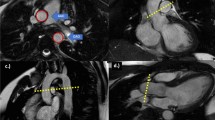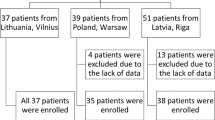Abstract
Background
This study aimed to evaluate hemodynamic phenotypes and prevalence of left ventricular hypertrophy in children after coarctation repair with right arm and leg blood pressure difference < 20 mmHg. Secondary objectives were analysis of effects of age at intervention, residual gradient across the descending aorta, and type of correction.
Methods
Blood pressure status and left ventricular hypertrophy were diagnosed according to European Society of Hypertension 2016 guidelines.
Results
Of 90 patients with a median age 12.5 (8.9–15.8) years, 8.5 (6.0–11.8) years after coarctation repair who were included, 42 (46.7%) were hypertensive. Isolated systolic hypertension dominated among 29 hypertensive patients with uncontrolled or masked hypertension (25 of 29; 86.2%). Of the 48 patients with office normotension, 14.6% (7) had masked hypertension, 8.3% (4) had ambulatory prehypertension, and 54.2% (26) were truly normotensive. Left ventricular hypertrophy was diagnosed in 29 patients (32.2%), including 14 of 42 (33.3%) hypertensive and 15 of 48 (31.3%) normotensive patients. The peak systolic gradient across the descending aorta was greater in hypertensive subjects (33.3 ± 12.7 mmHg) compared with normotensive subjects (25 ± 8.2 mmHg, p = 0.0008). Surgical correction was performed earlier than percutaneous intervention (p < 0.0001) and dominated in 40 of 48 (83.3%) normotensive versus 24 of 42 (57.1%) hypertensive patients (p = 0.006).
Conclusions
Arterial hypertension with isolated systolic hypertension as the dominant phenotype and left ventricular hypertrophy are prevalent even after successful coarctation repair. Coarctation correction from the age of 9 years and older was associated with a higher prevalence of hypertension.


Similar content being viewed by others
References
Hoffman JI, Kaplan S (2002) The incidence of congenital heart disease. J Am Coll Cardiol 39:1890–1900. https://doi.org/10.1016/s0735-1097(02)01886-7
Morgan GJ, Lee KJ, Chaturvedi R, Bradley TJ, Mertens L, Benson L (2013) Systemic blood pressure after stent management for arch coarctation implications for clinical care. JACC Cardiovasc Interv 6:192–201. https://doi.org/10.1016/j.jcin.2012.10.009
Torok RD, Campbell MJ, Fleming GA, Hill KD (2015) Coarctation of the aorta: management from infancy to adulthood. World J Cardiol 7:765–775. https://doi.org/10.4330/wjc.v7.i11.765
Kenny D, Polson JW, Martin RP, Paton JF, Wolf AR (2011) Hypertension and coarctation of the aorta: an inevitable consequence of developmental pathophysiology. Hypertens Res 34:543–547. https://doi.org/10.1038/hr.2011.22
Park MK, Mc Park’s The pediatric cardiology handbook. Fifth edn. Saunders.
Toro-Salazar OH, Steinberger J, Thomas W, Rocchini AP, Carpenter B, Moller JH (2002) Long-term follow-up of patients after coarctation of the aorta repair. Am J Cardiol 89:541–547. https://doi.org/10.1016/s0002-9149(01)02293-7
Lee MG, Allen SL, Kawasaki R, Kotevski A, Koleff J, Kowalski R, Cheung MM, Konstantinov IE, Brizard CP, d’Udekem Y (2015) High prevalence of hypertension and end-organ damage late after coarctation repair in normal arches. Ann Thorac Surg 100:647–653. https://doi.org/10.1016/j.athoracsur.2015.03.099
Choudhary P, Canniffe C, Jackson DJ, Tanous D, Walsh K, Celermajer DS (2015) Late outcomes in adults with coarctation of the aorta. Heart 101:1190–1195. https://doi.org/10.1136/heartjnl-2014-307035
Vriend JW, Mulder BJ (2005) Late complications in patients after repair of aortic coarctation: implications for management. Int J Cardiol 101:399–406. https://doi.org/10.1016/j.ijcard.2004.03.056
Canniffe C, Ou P, Walsh K, Bonnet D, Celermajer D (2013) Hypertension after repair of aortic coarctation--a systematic review. Int J Cardiol 167:2456–2461. https://doi.org/10.1016/j.ijcard.2012.09.084
Carr JA (2006) The results of catheter-based therapy compared with surgical repair of adult aortic coarctation. J Am Coll Cardiol 47:1101–1107. https://doi.org/10.1016/j.jacc.2005.10.063
Yang L, Chua X, Rajgor DD, Tai BC, Quek SC (2016) A systematic review and meta-analysis of outcomes of transcatheter stent implantation for the primary treatment of native coarctation. Int J Cardiol 223:1025–1034. https://doi.org/10.1016/j.ijcard.2016.08.295
Lurbe E, Agabiti-Rosei E, Cruickshank JK, Dominiczak A, Erdine S, Hirth A, Invitti C, Litwin M, Mancia G, Pall D, Rascher W, Redon J, Schaefer F, Seeman T, Sinha M, Stabouli S, Webb NJ, Wuhl E, Zanchetti A (2016) 2016 European Society of Hypertension guidelines for the management of high blood pressure in children and adolescents. J Hypertens 34:1887–1920. https://doi.org/10.1097/HJH.0000000000001039
Flynn JT, Daniels SR, Hayman LL, Maahs DM, McCrindle BW, Mitsnefes M, Zachariah JP, Urbina EM, American Heart Association Atherosclerosis H, Obesity in youth committee of the Council on Cardiovascular Disease in the Y (2014) update: ambulatory blood pressure monitoring in children and adolescents: a scientific statement from the American Heart Association. Hypertension 63:1116-1135. doi:https://doi.org/10.1161/HYP.0000000000000007
Kułaga Z, Litwin M, Tkaczyk M, Palczewska I, Zajączkowska M, Zwolińska D, Krynicki T, Wasilewska A, Moczulska A, Morawiec-Knysak A, Barwicka K, Grajda A, Gurzkowska B, Napieralska E, Pan H (2011) Polish 2010 growth references for school-aged children and adolescents. Eur J Pediatr 170:599–609. https://doi.org/10.1007/s00431-010-1329-x
Khoury PR, Mitsnefes M, Daniels SR, Kimball TR (2009) Age-Specific reference intervals for indexed left ventricular mass in children. J Am Soc Echocardiogr 22:709–714. https://doi.org/10.1016/j.echo.2009.03.003
Desimone G, Devereux RB, Daniels SR, Koren MJ, Meyer RA, Laragh JH (1995) Effect of growth on variability of left-ventricular mass - assessment of allometric signals in adults and children and their capacity to predict cardiovascular risk. J Am Coll Cardiol 25:1056–1062. https://doi.org/10.1016/0735-1097(94)00540-7
Lai WW, Mertens L, Cohen M, Geva T (2009) Echocardiography in pediatric and congenital heart disease : from fetus to adult. Second edn, Blackwell Publishing
National High Blood Pressure Education Program Working Group on High Blood Pressure in Children and Adolescents (2004) The fourth report on the diagnosis, evaluation, and treatment of high blood pressure in children and adolescents. Pediatrics 114(2 Suppl 4th Report):555–576
Brili S, Tousoulis D, Antoniades C, Aggeli C, Roubelakis A, Papathanasiu S, Stefanadis C (2005) Evidence of vascular dysfunction in young patients with successfully repaired coarctation of aorta. Atherosclerosis 182:97–103. https://doi.org/10.1016/j.atherosclerosis.2005.01.030
Ou P, Celermajer DS, Mousseaux E, Giron A, Aggoun Y, Szezepanski I, Sidi D, Bonnet D (2007) Vascular remodeling after “successful” repair of coarctation: impact of aortic arch geometry. J Am Coll Cardiol 49:883–890. https://doi.org/10.1016/j.jacc.2006.10.057
Vriend JWJ, Zwinderman AH, de Groot E, Kastelein JJP, Bouma BJ, Mulder BJM (2005) Predictive value of mild, residual descending aortic narrowing for blood pressure and vascular damage in patients after repair of aortic coarctation. Eur Heart J 26:84–90
Bambul Heck P, Pabst von Ohain J, Kaemmerer H, Ewert P, Hager A (2017) Survival and cardiovascular events after coarctation-repair in long-term follow-up (COAFU): Predictive value of clinical variables. Int J Cardiol 228:347–351. https://doi.org/10.1016/j.ijcard.2016.11.164
Bald M, Neudorf U (2000) Arterial hypertension in children and adolescents after surgical repair of aortic coarctation defined by ambulatory blood pressure monitoring. Blood Press Monit 5:163–167. https://doi.org/10.1097/00126097-200006000-00004
Eroglu AG, Oztunc EF (2000) Ambulatory blood pressure monitoring after successful repair of coarctation of the aorta at mid-term follow-up. Jpn Heart J 41:49–58
Parrish MD, Torres E, Peshock R, Fixler DE (1995) Ambulatory blood-pressure in patients with occult recurrent coarctation of the aorta. Pediatr Cardiol 16:166–171
Sorof JM, Poffenbarger T, Franco K, Bernard L, Portman RJ (2002) Isolated systolic hypertension, obesity, and hyperkinetic hemodynamic states in children. J Pediatr 140:660–666. https://doi.org/10.1067/mpd.2002.125228
Palatini P, Rosei EA, Avolio A, Bilo G, Casiglia E, Ghiadoni L, Giannattasio C, Grassi G, Jelakovich B, Julius S, Mancia G, McEniery CM, O’Rourke MF, Parati G, Pauletto P, Pucci G, Saladini F, Strazzullo P, Tsioufis K, Wilkinson IB, Zanchetti A (2018) Isolated systolic hypertension in the young: a position paper endorsed by the European Society of Hypertension. J Hypertens 36:1222–1236. https://doi.org/10.1097/HJH.0000000000001726
O’Rourke MF, Nichols WW (2005) Aortic diameter, aortic stiffness, and wave reflection increase with age and isolated systolic hypertension. Hypertension 45:652–658. https://doi.org/10.1161/01.HYP.0000153793.84859.b8
Brown ML, Burkhart HM, Connolly HM, Dearani JA, Cetta F, Li Z, Oliver WC, Warnes CA, Schaff HV (2013) Coarctation of the aorta: lifelong surveillance is mandatory following surgical repair. J Am Coll Cardiol 62:1020–1025. https://doi.org/10.1016/j.jacc.2013.06.016
Hager A, Kanz S, Kaemmerer H, Schreiber C, Hess J (2007) Coarctation Long-term Assessment (COALA): significance of arterial hypertension in a cohort of 404 patients up to 27 years after surgical repair of isolated coarctation of the aorta, even in the absence of restenosis and prosthetic material. J Thorac Cardiovasc Surg 134:738–745. https://doi.org/10.1016/j.jtcvs.2007.04.027
Petropoulos AC, Moschovi M, Xudiyeva A, Qarayev F, Isayev I (2017) Late coarctation presenters suffer chronic hypertension resisting to medicine treatment. Open Journal of Pediatrics and Child Health 3:001–008. https://doi.org/10.17352/2640-7612.000012
McCrindle BW (2010) Assessment and management of hypertension in children and adolescents. Nat Rev Cardiol 7:155–163. https://doi.org/10.1038/nrcardio.2009.231
Vigneswaran TV, Sinha MD, Valverde I, Simpson JM, Charakida M (2018) Hypertension in coarctation of the aorta: challenges in diagnosis in children. Pediatr Cardiol 39:1–10. https://doi.org/10.1007/s00246-017-1739-x
Di Salvo G, Castaldi B, Baldini L, Gala S, Del Gaizo F, D’Andrea A, Limongelli G, D'Aiello AF, Scognamiglio G, Sarubbi B, Pacileo G, Russo MG, Calabrò R (2011) Masked hypertension in young patients after successful aortic coarctation repair: impact on left ventricular geometry and function. J Hum Hypertens 25:739–745. https://doi.org/10.1038/jhh.2010.118
Franklin SS, O’Brien E, Staessen JA (2017) Masked hypertension: understanding its complexity. Eur Heart J 38:1112–1118. https://doi.org/10.1093/eurheartj/ehw502
Ogedegbe G, Agyemang C, Ravenell JE (2010) Masked hypertension: evidence of the need to treat. Curr Hypertens Rep 12:349–355. https://doi.org/10.1007/s11906-010-0140-4
Rinnström D, Dellborg M, Thilén U, Sörensson P, Nielsen N-E, Christersson C, Johansson B (2016) Left ventricular hypertrophy in adults with previous repair of coarctation of the aorta; association with systolic blood pressure in the high normal range. Int J Cardiol 218:59–64. https://doi.org/10.1016/j.ijcard.2016.05.033
Krieger EV, Clair M, Opotowsky AR, Landzberg MJ, Rhodes J, Powell AJ, Colan SD, Valente AM (2013) Correlation of exercise response in repaired coarctation of the aorta to left ventricular mass and geometry. Am J Cardiol 111:406–411. https://doi.org/10.1016/j.amjcard.2012.09.037
Availability of data and material
Initial data is not available under open access currently.
Funding
This project was supported by the Association for European Paediatric and Congenital Cardiology (AEPC) junior member research grant.
Author information
Authors and Affiliations
Corresponding author
Ethics declarations
Conflict of interest
The authors declare that they have no conflict of interest.
Ethics approval
The authors assert that all procedures contributing to this work comply with the ethical standards of the relevant national guidelines on human experimentation and with the Helsinki Declaration of 1975, as revised in 2008, and approved by the bioethics committees of Vilnius, Lithuania; Riga, Latvia; and Warsaw, Poland.
Statement of informed consent
Consent to participate and for publication was signed by all patients and their parents or legal representatives.
Additional information
Publisher’s note
Springer Nature remains neutral with regard to jurisdictional claims in published maps and institutional affiliations.
Rights and permissions
About this article
Cite this article
Sendzikaite, S., Sudikiene, R., Tarutis, V. et al. Prevalence of arterial hypertension, hemodynamic phenotypes, and left ventricular hypertrophy in children after coarctation repair: a multicenter cross-sectional study. Pediatr Nephrol 35, 2147–2155 (2020). https://doi.org/10.1007/s00467-020-04645-w
Received:
Revised:
Accepted:
Published:
Issue Date:
DOI: https://doi.org/10.1007/s00467-020-04645-w




